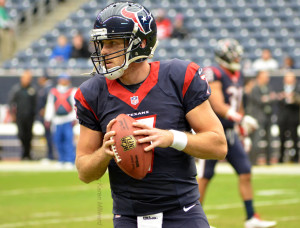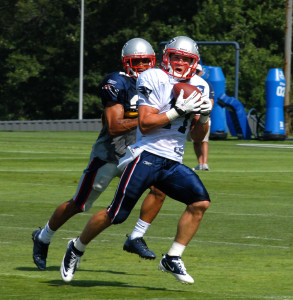 Case Keenum was sacked, fell hard on the turf, and immediately grabbed his head. Although a teammate tried helping him up, he went down again on all fours. Keenum remained in the game, stumbling around the football field with no medical attention provided. It was obvious to everyone watching that Keenum suffered a concussion, but there was no call from the concussion spotters asking the game to be stopped to evaluate him. The coaching staff didn’t check to see if he was okay. Instead, they began warming up a possible replacement in case Keenum needed to come out of the game, but he never did. It was later confirmed that Keenum did indeed suffer a concussion during that game.
Case Keenum was sacked, fell hard on the turf, and immediately grabbed his head. Although a teammate tried helping him up, he went down again on all fours. Keenum remained in the game, stumbling around the football field with no medical attention provided. It was obvious to everyone watching that Keenum suffered a concussion, but there was no call from the concussion spotters asking the game to be stopped to evaluate him. The coaching staff didn’t check to see if he was okay. Instead, they began warming up a possible replacement in case Keenum needed to come out of the game, but he never did. It was later confirmed that Keenum did indeed suffer a concussion during that game.
Earlier in 2015, Julian Edelman took a hit with eleven minutes left in the game. Although he appeared woozy, he continued to play despite the fact that the NFL concussion spotters radioed down to the Patriots that he needed attention. As a result of this play, the NFL made a rule change for concussions known as the “Julian Edelman Rule.” This new rule allows the concussion spotters to signal down to the officials on the field and call a medical timeout if a player is exhibiting concussive symptoms, but hasn’t had a chance to be evaluated by the team doctor. So far, during the 2015-2016 season, there have only been three cases where the Julian Edelman Rule has been invoked.
Currently, concussion spotters are certified by the National Athletic Trainers’ Association, with a minimum of ten years experience as an athletic trainer, major college and/or professional sports experience, never employed as a head athletic trainer by an NFL team, and not employed by an NFL team in the past 20 years. With these credentials, it seems the objectivity of the concussion spotters permits them to perform their jobs flawlessly. To the contrary, these independent certified athletic trainers (ATC spotters) are not pe rforming their job as expected. Players often do not tell their team when they’re suffering concussion symptoms. The spotters’ job is to protect the players safety to keep them from causing further harm and provide immediate medical attention if necessary. This season, concussion spotters failed to spot multiple concussion incidents, which resulted in players remaining in the game, leading the NFL Players Association to investigate into the failure to act by ATC spotters.
rforming their job as expected. Players often do not tell their team when they’re suffering concussion symptoms. The spotters’ job is to protect the players safety to keep them from causing further harm and provide immediate medical attention if necessary. This season, concussion spotters failed to spot multiple concussion incidents, which resulted in players remaining in the game, leading the NFL Players Association to investigate into the failure to act by ATC spotters.
Unfortunately, it appears the NFL may have implemented this new concussion rule only to appeal to public criticism regarding the detrimental effects of concussions as well as the obvious concussion suffered by Edelman. On its face, the Julian Edelman Rule seemed to be a step in the right direction on NFL’s part. However, ATC spotters are limited to stopping the play only if the player demonstrates, “with clear and visual evidence”, “obvious signs of disorientation or is clearly unstable.” Prior to this rule, most spotters would likely catch these “obvious” concussions, but it’s the overall concussion rate that the NFL should be trying to minimize and take preventative measures against.
The new rule seems to be backfiring on the NFL when players, like Keenum, suffer concussions that are left unattended. The spotters are expected to stop the game for medical attention whenever a concussion occurs, but players are still suffering from head trauma. This leads to more questions regarding the procedures that the NFL and the individual teams are taking to protect their players.
